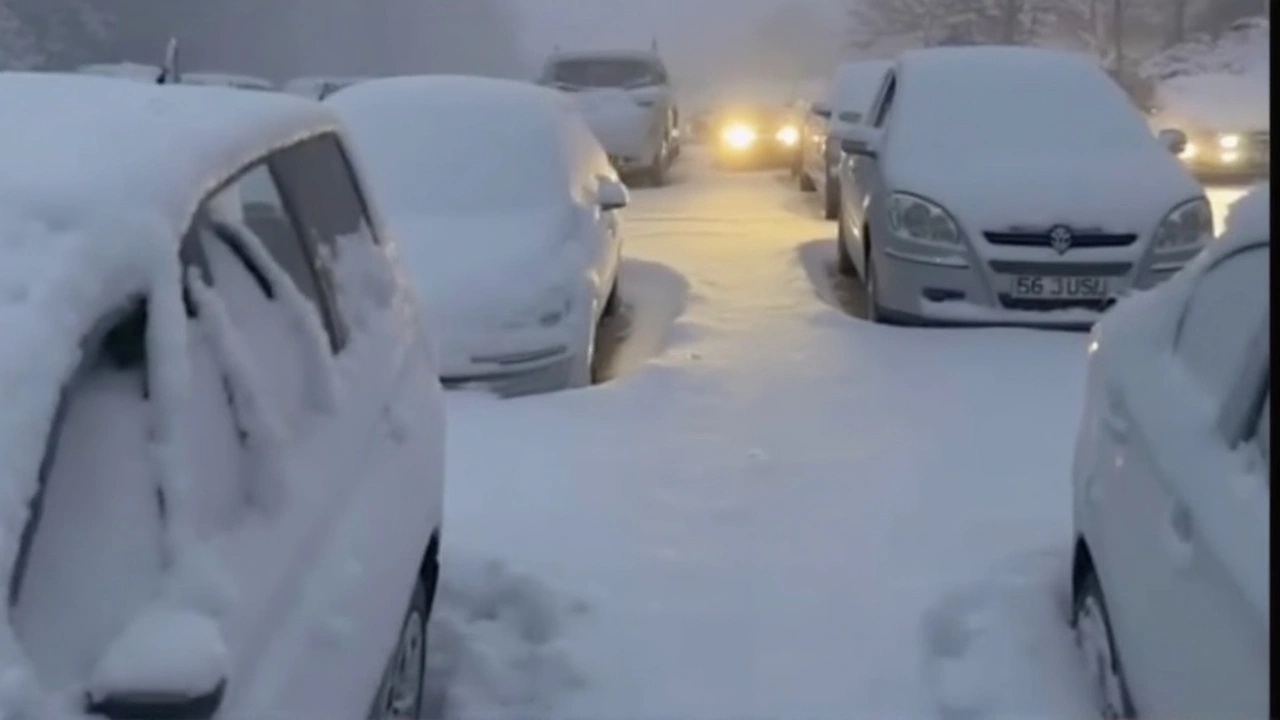Unprecedented Snowstorm Freezes South Africa
It’s not something you hear about often: South Africa buried under meters of snow and hundreds of people trapped in their cars overnight. But from September 20 to 24, 2024, a powerful snowstorm hammered much of the country, sending provinces like Gauteng, Free State, KwaZulu-Natal, Mpumalanga, and the Eastern Cape into chaos. For a region more used to mild winters, this blizzard didn’t just disrupt travel—it turned highways into icy parking lots and put lives at risk.
The N3 highway, South Africa’s busy connection between Johannesburg and Durban, became the storm’s epicenter. Drivers found themselves stranded between the Tugela Plaza and Harrismith as thick snow and black ice forced one of the country’s most critical routes to close. Some travelers didn’t move for more than 24 hours, stuck in freezing cars with no food, water, or way to get warm. A handful tried to walk to safety, but even that proved dangerous; reports described snow piling up to six feet high, turning roadsides into frozen barriers.
Tragedy, Rescue Efforts, and Ongoing Dangers
The freezing temperatures turned deadly. Emergency teams confirmed two people died of hypothermia during the ordeal: one was a 39-year-old woman found in a stranded minibus, and the other passed away overnight, likely unable to withstand the biting cold. Even as the South African Police Service, the National Roads Agency (SANRAL), and organizations like the N3 Toll Concession scrambled to reach those in trouble, the scale of the blizzard meant many had to huddle together and wait for help that took hours to arrive.
Rescue crews made sure the most vulnerable—kids, the elderly, and people with medical needs—were the first to get supplies and warmth. But resources were stretched thin. Motorists described their frustration as communication networks became patchy, and updates on the roads’ status rarely brought good news. Humanitarian teams distributed blankets, food, and water once they managed to reach the trapped vehicles, but for many, the wait was a long test of patience and endurance.
And the dangers didn’t end once the plows started clearing roads. As the snow began to melt, new risks popped up—especially in KwaZulu-Natal, where river levels rose quickly. Flood warnings went out, with disaster managers pointing to the threat along rivers like the Tugela. Schools closed across several districts, and local officials begged families to keep their children away from flood-prone water. Cooperative Governance Minister Thulasizwe Buthelez made a clear point: what starts as snow can quickly turn to severe flooding, especially for curious kids who just want to play in the runoff.
N3 Toll Concession’s operations manager Thania Dhoogra called attention to the “round-the-clock” rescue and recovery jobs happening since the start of the storm. By September 24, mop-up crews were out, but big travel advisories stayed in place—no one wanted a quick return to traffic on roads that might still be holding black ice beneath the muddy slush. Full re-opening dates were still up in the air, with the government promising updates once things were truly safe.
For many in South Africa, this storm will be hard to forget—a rare display of nature’s power in a usually temperate part of the world. It left behind more than just icy roads and school closures: the scars of panic, loss, and heroic effort will stick with drivers and their families for a long time.






Daniel Craine
July 29, 2025 AT 17:41Well, look at that, a snowstorm in a country that usually drinks sunshine, and the media rushes to the scene like it’s a blockbuster, every headline screaming about how “unprecedented” the disaster is, while the locals are just trying to thaw out their cars, and the officials are scrambling to clear the N3, and the rescue teams are battling black ice that seems to appear out of nowhere, all while forecasts keep flipping between snow and rain, it’s a chaotic circus, and honestly, the world could use a little less drama and a lot more practical aid.
santhosh san
August 2, 2025 AT 05:01It is so heartbreaking to think about people stuck in freezing cars, the cold is not just a weather thing it’s a human crisis, I can feel the sorrow for the families who lost someone, and for those who are just trying to survive this nightmare, this is not some movie set it’s real life suffering, and it makes me think how fragile our comfort really is.
Kristen VanPamel
August 5, 2025 AT 16:21The snow that fell across South Africa was not merely an atmospheric anomaly it was a stark reminder that climate patterns are shifting in ways that defy historical expectations the volume of snow reported in provinces unaccustomed to such precipitation suggests an unprecedented thermal inversion that allowed moisture to accumulate at lower altitudes the resulting ice on the N3 transformed a major artery into a frozen wasteland drivers, unaware of the severity, were caught in a limbo between progress and peril the lack of real‑time communication exacerbated the sense of isolation for those trapped inside their vehicles the human body, when exposed to temperatures well below freezing, enters a state of hypothermia much faster than most realize the two reported deaths underline the lethal potential of even short exposure the emergency response teams, operating under difficult conditions, displayed commendable coordination and bravery despite limited resources they prioritized vulnerable groups such as children and the elderly the distribution of blankets and hot beverages, though delayed, provided essential heat to stave off further casualties the melt that followed introduced a secondary threat of flooding especially in river valleys where water levels surged rapidly the authorities’ warning about flood risks was timely yet many residents remained oblivious to the swift change in danger the disruption of schools and local services amplified the broader societal impact of the storm a comprehensive review of infrastructure resilience will be necessary if such events become more frequent the psychological trauma experienced by motorists and their families may linger long after the roads are cleared the incident also raises questions about preparedness in regions historically considered temperate the interplay between climate change and extreme weather events demands a proactive approach from policymakers and citizens alike the narrative of this blizzard will likely shape future disaster response strategies in South Africa and perhaps serve as a cautionary tale for other nations unprepared for sudden severe winter conditions
Reid Vance
August 9, 2025 AT 03:41Yo, did you guys see how the N3 turned into a giant ice rink? That stretch between Tugela Plaza and Harrismith is usually a lifeline for commuters, now it’s a winter wonderland for the unlucky. I read that SANRAL deployed over 50 plows and salt trucks, but black ice still claimed victims. The rescue crews even used thermal imaging drones to locate stranded vehicles – talk about high tech! And apparently, the flooding in KwaZulu‑Natal could push the Tugela River over its banks by the weekend. If you’re planning a road trip, skip the N3 until further notice, or better yet, grab a flight. Also, the government promised a “round‑the‑clock” operation, which apparently means crews are working 24/7, no joke. Stay safe out there, folks, and keep the heaters on!
Javier cox
August 12, 2025 AT 15:01I think we should all remember that this kind of weather is not normal for SA, but it’s defintely a sign that we need to be better prepared, maybe more snow plows or better road signts. The drivers who got stuck were probably not expecting this at all, and they deserved some faster help. Lets hope the govmnent learns from this and puts more resources into emergency response.
Giacinta Pace
August 16, 2025 AT 02:21Hang in there, everyone! Even though the storm was scary, the community really came together, sharing blankets and food. It’s amazing how people can look out for each other when things get tough.
darryl archer
August 19, 2025 AT 13:41In light of the recent meteorological events, it is incumbent upon us to review transportation protocols, as the present circumstances have demonstrated a veritable lapse in preparedness. The shortcomings observed, particularly with regard to the timely deployment of de‑icing agents, must be addressed forthwith. It is hoped that forthcoming policy revisions will rectify these infractions, ensuring that future occurrences are managed with alacrity and competence. It is essential that the administration also considers the logistical challenges faced by remote regions, and that future strategies incorporate both preventive and reactive measures, thereby safeguarding the public and restoring confidence in the national infrastructure, while also addressing any competance gaps identified during the recent emergency response.
Dina DiCicco
August 23, 2025 AT 01:01This disaster was a clear example of how unprepared we are, and it’s unacceptable! 🚨 The authorities need to step up their game and provide faster assistance, not wait hours for basic supplies! ⚡️
Kasey DellaPenna
August 26, 2025 AT 12:21People were stuck in cars for days the heat from the engine barely kept anyone warm the rescue crews finally got there they did a great job helping everyone stay safe
Gayleen Lowrie
August 29, 2025 AT 23:41It’s encouraging to see the rescue teams prioritize children and the elderly, providing blankets and hot drinks when needed. Such dedication makes a huge difference in these dire moments.
Wesley Nakamatsu
September 2, 2025 AT 11:01While foreign media may sensationalize the event, it is essential to recognize the resilience of South African citizens in the face of adversity. Our nation’s spirit remains unbroken, and we shall continue to protect our roads and people with steadfast determination.
Tyler Tucker
September 5, 2025 AT 22:21This whole blizzard thing is just ridiculous.
julia mutambara
September 9, 2025 AT 09:41It’s truly inspiring how quickly communities rallied together, offering aid to strangers stranded on the icy highways, demonstrating that humanity can shine brightest amid the darkest cold; the volunteers who handed out blankets and hot tea showed a generosity that transcended mere duty, reminding us that even in moments of extreme hardship, compassion can prevail, and the rescue operators working through the night embodied a perseverance that should be celebrated across the nation, for every gasp of warm breath in a frozen car signified hope, and every tire that finally turned on cleared roadways symbolized a step toward normalcy, as schools reopened and families reunited, the lingering chill in the air seemed less a threat and more a testament to our collective strength, and when the floodwaters receded, the lessons learned about preparedness will stay with us, guiding future policies, ensuring that no one is left to face such a storm alone, because together we can turn a terrifying snowstorm into a story of bravery and solidarity that will be told for generations to come.
Nelleke Elston
September 12, 2025 AT 21:01Sure, the snow was insane, but let’s not act like it was the end of the world – we’ve survived droughts, heatwaves, and now a freak blizzard, so maybe it’s time to stop overreacting and start fixing the real infrastructure gaps instead of just tweeting about the cold.